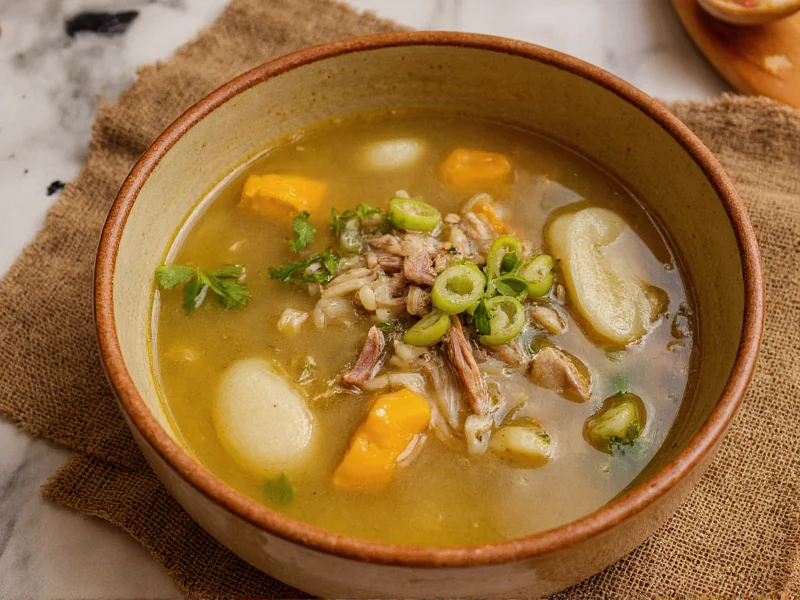Understanding what makes a soup truly clear requires examining both culinary science and cultural traditions. Professional chefs achieve clarity by maintaining broth temperatures below boiling point, using egg whites or lean meats to trap impurities, and carefully selecting ingredients that won't cloud the liquid. This delicate balance transforms simple ingredients into elegant culinary presentations found across global cuisines.
The Science Behind Soup Clarity
Cloudiness in soup typically occurs when fat emulsifies into the broth or when starches from vegetables break down. Clear soups avoid these issues through specific techniques:
| Clarity Factor | Cloudy Soup Cause | Clear Soup Solution |
|---|---|---|
| Liquid Base | Boiling broth vigorously | Gentle simmer below 180°F (82°C) |
| Ingredient Selection | Starchy vegetables like potatoes | Non-starchy vegetables like daikon or bok choy |
| Impurity Removal | Sediment from bones or vegetables | Egg white clarification or careful skimming |
| Fat Management | Emulsified fat droplets | Chilling and skimming solidified fat |
Global Variations of Clear Soup
Cultures worldwide have perfected their own versions of clear soup, each reflecting local ingredients and culinary traditions. Japanese suimono features delicate dashi broth with minimal ingredients, while French consommé represents the pinnacle of European clarification techniques. Chinese qing tang (clear soup) often serves as the base for hot pot preparations, and Korean guk varieties frequently appear in traditional meals.
When exploring traditional Japanese clear soup preparation, chefs often use kombu (kelp) and bonito flakes to create dashi without boiling, preserving the broth's natural clarity. This technique differs significantly from Western consommé methods that employ egg whites to form a clarifying raft that traps impurities.
Nutritional Benefits and Digestive Advantages
Clear soups offer notable health advantages compared to cream-based alternatives. Their light composition makes them ideal for sensitive digestive systems, particularly during recovery from illness. The absence of heavy creams or pureed vegetables creates a low-calorie option rich in minerals extracted from bones and vegetables during slow simmering.
Many healthcare professionals recommend clear soup for digestion due to its gentle nature on the gastrointestinal tract. Unlike creamy soups that require more digestive enzymes, clear broths move through the system efficiently while still providing hydration and essential electrolytes. This makes traditional clear soup recipes valuable components of post-illness dietary protocols and cleansing regimens.
Mastering Clear Soup Preparation at Home
Achieving professional-quality clarity in home cooking requires attention to detail but doesn't demand specialized equipment. Start with cold water when making bone broth, gradually bringing it to temperature to allow impurities to coagulate for easier removal. Skim diligently during the first 20 minutes of heating, as this captures the majority of particles that would cloud your finished soup.
For those wondering why is my soup not clear despite careful preparation, consider these common pitfalls: adding ingredients that release starches, boiling instead of simmering, or using previously frozen bones that release more impurities. When making Asian clear soup recipes, remember that many traditional preparations begin with pre-made dashi or stock rather than raw bones, which naturally produces clearer results.
Cultural Significance and Modern Applications
Clear soups serve important roles in culinary traditions worldwide. In Chinese dining etiquette, clear soup often appears midway through a meal to cleanse the palate. French consommé traditionally begins formal dinners, while Japanese clear soups accompany nearly every traditional meal. Modern chefs are rediscovering these techniques, applying traditional clear soup methods to innovative flavor combinations while maintaining visual elegance.
Frequently Asked Questions
What's the difference between consommé and regular clear soup?
Consommé undergoes a specific clarification process using egg whites and ground meat to form a 'raft' that traps impurities, resulting in exceptional clarity. Regular clear soup achieves transparency through careful simmering and skimming without the clarification step, making it simpler to prepare but potentially less crystal-clear than consommé.
Can I make clear soup without meat or bones?
Yes, vegetarian clear soups are possible using vegetable scraps, mushrooms, and kombu. The key is gentle simmering and careful straining. For optimal clarity without animal products, use non-starchy vegetables like daikon, leeks, and celery, avoiding ingredients that release starches or cloud the broth.
How long should clear soup simmer for best results?
Most clear soups require 1-2 hours of gentle simmering. Bone-based broths may need longer (up to 4 hours), but must remain below boiling point. The critical factor isn't duration but temperature control—maintaining a temperature where small bubbles occasionally break the surface (160-180°F or 70-82°C) ensures optimal clarity without clouding.
Why does my clear soup become cloudy when I add vegetables?
Certain vegetables release starches or pigments that cloud broth. Potatoes, corn, and starchy root vegetables are common culprits. For clear soup, use non-starchy vegetables like bok choy, spinach, or thinly sliced daikon added at the very end of cooking. Blanching vegetables separately before adding to the soup also prevents cloudiness.
Can I freeze clear soup without losing clarity?
Yes, but with precautions. Cool the soup rapidly before freezing to maintain clarity. When reheating, avoid boiling—gently warm the soup to preserve its transparent quality. Some separation may occur during freezing, but careful reheating should restore most of the original clarity.











 浙公网安备
33010002000092号
浙公网安备
33010002000092号 浙B2-20120091-4
浙B2-20120091-4